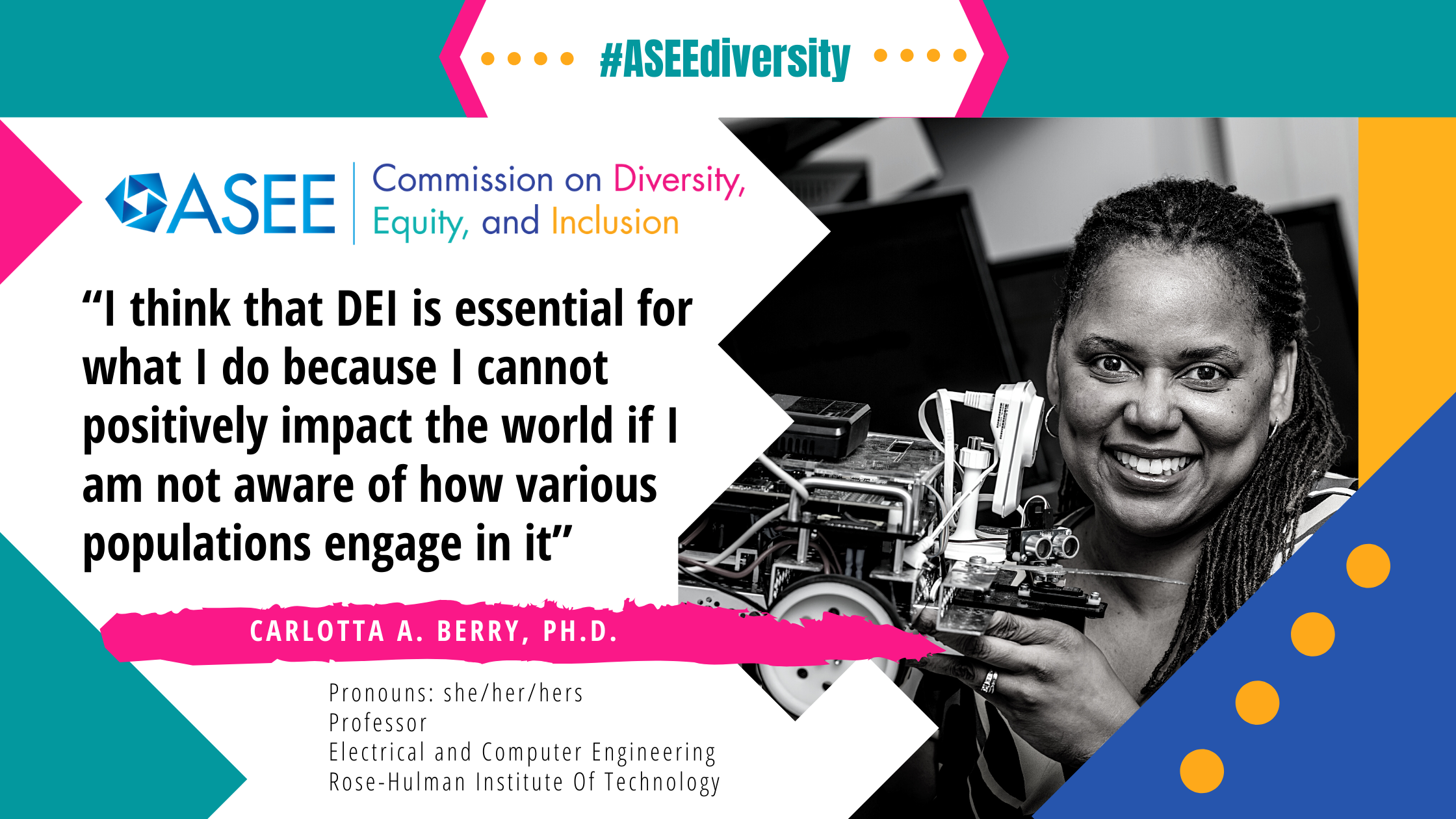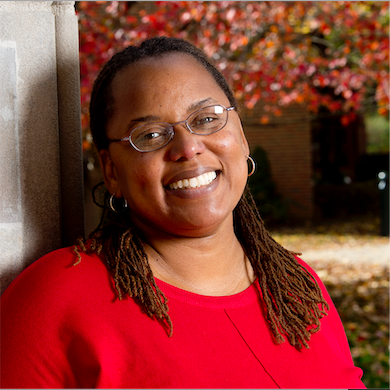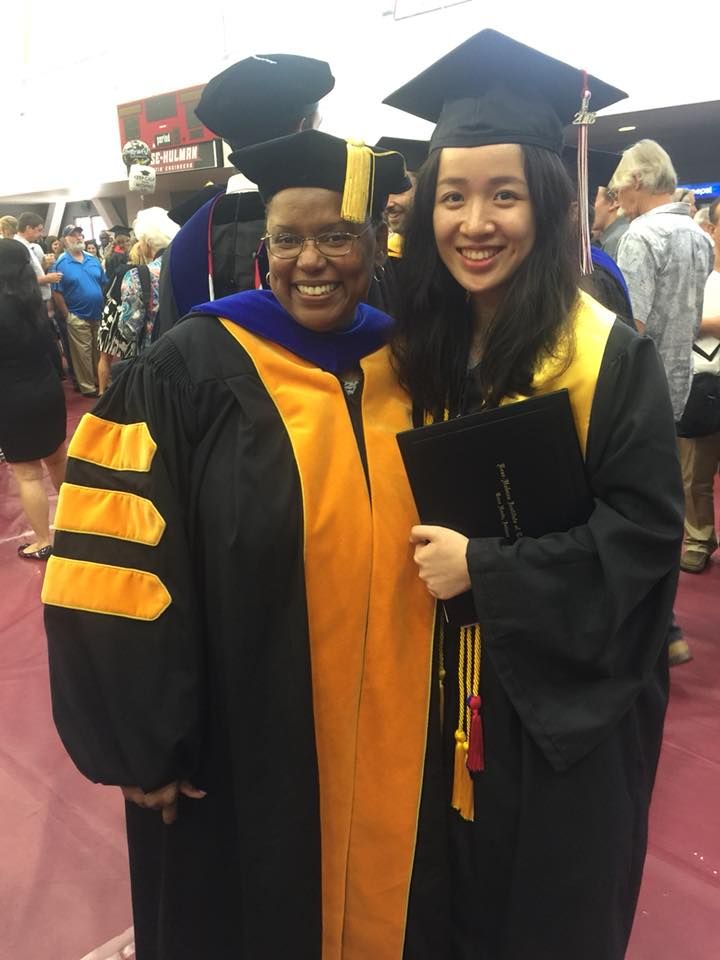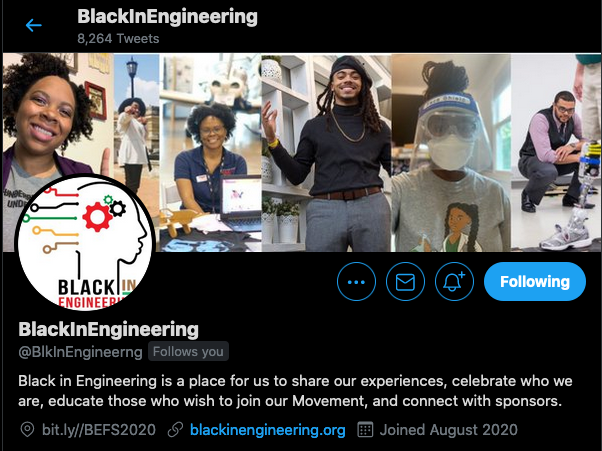
ASEE CDEI Scholar Spotlight Series: Dr. Carlotta A. Berry

Dr. Carlotta A. Berry: From trailblazer to building a strong community and network to foster allyship and confidence among engineering students
From being one of the first Black women in an engineering class, Dr. Berry has created an accomplished career dedicated to diversity and inclusion in engineering. Dr. Carlotta Berry’s areas of expertise include educational mobile robotics and enhanced human-robot interfaces. Her education work focuses on connecting engineering robotics with every engineer’s professional mission to solve problems for a more just society.
Her mission for social justice expands beyond her classroom. Besides her many honors and roles, she initiated and currently leads many local and national initiatives to increase Black professionals’ participation in STEM. Enjoy learning about Carlotta’s story, current work, insights, and plans on Diversity, Equity, and Inclusion (DEI).
At the end of this post, don’t miss out on the opportunity to connect with our scholar and learn more about the ASEE CDEI‘s efforts.
ASEE CDEI Communications Committee Volunteers:
- Introduction, editor, and webmaster: Sindia M. Rivera-Jiménez, Ph.D., University of Florida (Twitter)
Scholar Interview
Q: Can you tell us your story of belongingness?

Pronouns: she/her/hers, Professor, Electrical and Computer Engineering, Rose-Hulman Institute of Technology
I think my story of belonging within engineering, the academy, and industry has grown with time. Unfortunately, being one of only a few black women in an engineering class and now in the engineering academy means that there is a strong sense of imposter syndrome. Part of my mission is to not only overcome that myself by building a strong sense of community and network but also encouraging my students to establish their own networks and allies to help with that confidence. Of course, this is easier said than done, and it took many years to get me to my current state of comfort and confidence. I think this comes with experiencing success in the field and also recognizing how important my voice is. No one else can provide the experience and unique perspective that I can. I belong here because, without me, some of my colleagues and students would not get to interact with a person of color or scholar to appreciate the value of that interaction and what we can bring to the table. My story of belongingness came from me recognizing my value and the quality of what I had to give that would not happen without me. When I was in the industry, I had similar experiences with colleagues who did not understand how to interact with such a young Black engineer and were often intrigued with how I thought and why I did the things I did. Once I realized that I was fearfully and wonderfully made and approached the world as my unapologetic self, others had no choice but to meet me where I was and appreciate what I brought to the table.
As a Black woman who moves in predominantly white male-dominated spaces, I don’t have the luxury of not having some recognition and understanding of how others function and operate in these spaces.
Q: What is your understanding of DEI and why it is important to what you do?
I think that DEI is essential for what I do because I cannot positively impact the world if I am not aware of how various populations engage in it. As an engineer, my primary purpose is to improve the world by using math and science to create solutions to the world’s problems. Still, if I view these from a very narrow lens, then my focus will be off and my solution may only work for a very narrow population. As a Black woman who moves in predominantly white male-dominated spaces, I don’t have the luxury of not having some recognition and understanding of how others function and operate in these spaces. I like to encourage others also to attempt to do the same for other populations. I push my colleagues on this because I feel it is everyone’s responsibility to do the diversity work on campus and have conversations to learn about others’ perspectives beyond their own little bubble. I don’t have the luxury to do otherwise just by being a Black woman engineering professor. They will often come to me about diversity questions or do diversity work, and it is really unfair to put more invisible labor on the already historically marginalized populations. Of course, we are happy and willing to help because we want to see campus diversity improve, but we don’t have the power and did not create the structures. For true, significant change to happen, it needs to come from a larger population and the administration as well.
Q: What do you see as the next steps for your DEI work?
On my campus, I continue to work with the ROSE-BUD scholars program, which aims to increase the number of women and historically marginalized and minoritized students in computer science, electrical, computer and software engineering who enroll, graduate, and develop professionally. In the program, students are expected to be campus leaders, participate in diversity initiatives, maintain a certain GPA, do networking and community building, and complete at least 2 internships or research experiences before graduation.
In my teaching, particularly freshman design, I have introduced examples of how lack of diversity on a team has produced designs that do not work for diverse populations. I explain what it means to be an engineer and use math and science to create solutions and processes for society’s problems that will work for all people. I discuss the initial problems using real examples such as crash test dummies and some soap dispensers that used skin color to activate.
In my larger professional community, I worked with Dr. Monica Cox (Twitter) and Dr. Tahira Reid-Smith (Twitter) to start the Black In Engineering initiative, a social justice movement to support Black students, faculty, researchers, and engineering practitioners. As part of this work, we have done podcasts, articles, interviews, videos, workshops/roundtables, Black In Engineering week on Twitter in collaboration with Black in Computing (Twitter), and released a Call To Action.
For the next steps, I think it is important to review the numerous calls to action that have recently come out of the STEM community and use them to determine how to integrate the initiatives into your work on campus or in the classroom.
See the following links:
- Black In Engineering
- Black In Computing
- Black2STEM: Combating Systemic Racism in Higher Education: An Open Letter to STEM from Faculty of Color
Q: What recommendations do you have for engineering educators to start incorporating social justice topics in their classrooms?

Berry with undergraduate students in her robotics classroom.
I think it is important to do readings on topics and figure out how to connect those to what you teach. One initiative I am currently working on with a group is promoting black scholars in the field to make them ubiquitous. One way to do this is to assign readings from diverse populations or introduce their work in lectures. I try to do this in my mobile robotics course by presenting the work of women roboticists. I am also a part of a group developing a Black In Robotics reading list to recognize more diverse scholars in fields where they are typically marginalized, or there are one of only a few that everyone looks to. Also, identify examples related to your course topic to introduce as part of a discussion and assignments.
Q: What is one resource that you can recommend to people who want to learn more about DEI in your field?
This summer has proven to be powerful for creating several Black IN STEM resources, and I highly recommend reviewing some of them on the Black In Engineering and BlackInComputing.org websites. There is also a new BlackInRobotics.org website, but it is not fully developed as of yet.
Recommended ASEE PEER paper from our scholar:
Pannier, C., & Berry, C. A., & Morris, M., & Zhao, X. (2020, June), Diversity and Inclusion in Mechatronics and Robotics Engineering Education Paper presented at 2020 ASEE Virtual Annual Conference Content Access, Virtual On line . 10.18260/1-2–34471
The paper assesses the current status of women and underrepresented minorities and investigates solutions to increase diversity and support the inclusion of these groups, specifically in mechatronics and robotics engineering. The paper examines challenges and potential solutions using a combination of qualitative text analysis and online survey data. They found that curriculum reform to incorporate social context into engineering education and expand STEM outreach by colleges to elementary and middle schools seems to be one of the most promising new ideas. This paper is a gem with a lot of practical information.
Find more articles on ASEE Peer for this scholar: Berry

Dr. Berry celebrating her student, Rey, graduation day.
Connect with our scholar:
- Website(s): Professional Site, BlackInRobotics.org, and Black In Engineering
- Connect in social media:Instagram, Twitter
Getting involved with CDEI
- If you want to recommend someone for our Spotlight series click here.
- Check out website Highlights:
- Resources
- Past Blogs and Events
- Compilation of Newsletters and Reports
- Connect with the committee:
- Become a Friend of the Committee
- Follow us and tag us on Twitter
- Become a volunteer on our Communications Committee! We are always looking for people that want to share or improve their writing and leadership skills.
Check out other Spotlight Scholars:
- Dr. Homero Murzi: Creating culturally responsive environments by focusing on the voices of our engineering students
- Dr. Tony E. Butterfield: Empowering faculty and students to create an inclusive environment for the LGBTQ+ community

